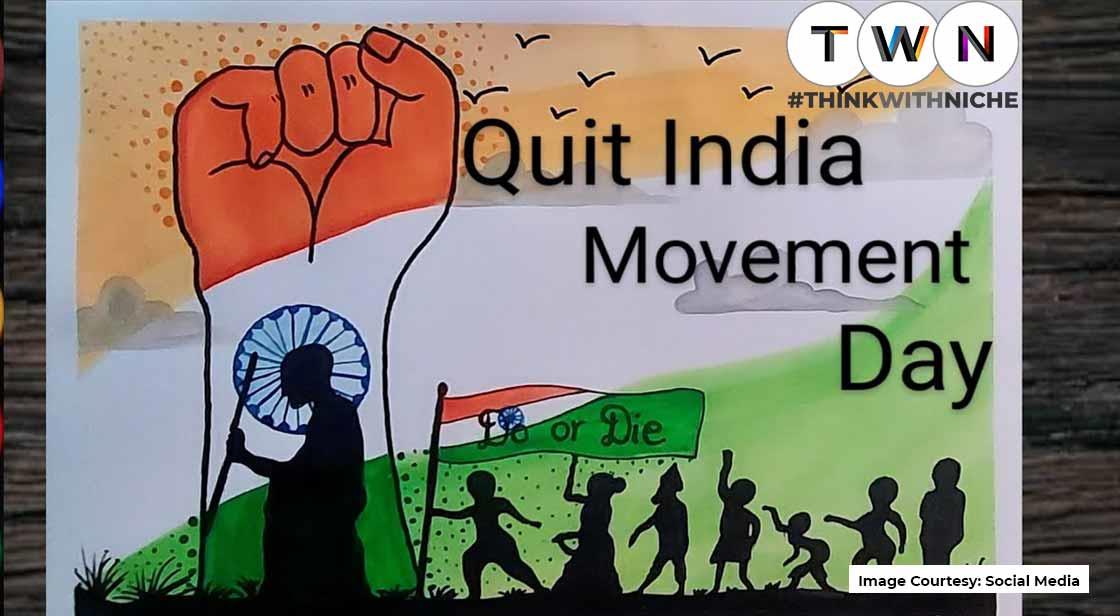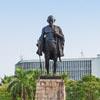All About Quit India Movement

Blog Post
The Quit India Movement also known as 'Bharat Choro Andolan' was launched on on August 8, 1942 by the Indian National Congress at Bombay's session of the "All-India Congress Committee." The sole purpose of the movement was to force the British out of India. The leader of the movement was Mahatma Gandhi. He gave an inspiring speech entitled "Do or Die!" At Bombay's Gowalia Tank Maidan, (now Mumbai), he delivered a fiery 'Quit India' speech. The British didn't focus all their energy on Second World War, but were prepared to take action against Congress leaders. Gandhi called for 'Bharat Chhodo Andolan (Quit India Movement), on August 8, 1942, after the failure of the 'Cripps mission. In the hope of gaining immediate independence from Britain, the movement was started. Gandhi's desire for immediate independence was also strongly influenced by his fear about a Japanese invasion of India, and the supposed inability of the British to defend India during such an event.
#MahatmaGandhi
#QuitIndiaMovement
#IndianFreedomStruggle
#Azadi Ka Amrit Mahotsav
#IndianIndependenceMovement
#75thAnniversaryOfIndependence
As India celebrates 'Azadi Ka Amrit Mahotsav', an initiative of the Government of India to celebrate and commemorate 75 years of independence and the glorious history of it's people, culture and achievements, lets take a look at the renowned 'Quit India Movement' which was an important part of the India's struggle for freedom. The Quit India Movement also known as 'Bharat Choro Andolan' was launched on on August 8, 1942 by the Indian National Congress at Bombay's session of the "All-India Congress Committee."
The sole purpose of the movement was to force the British out of India. The leader of the movement was Mahatma Gandhi. He gave an inspiring speech entitled "Do or Die!" At Bombay's Gowalia Tank Maidan, (now Mumbai), he delivered a fiery 'Quit India' speech. The British didn't focus all their energy on Second World War, but were prepared to take action against Congress leaders. Within hours of the movement's launch, most of the leaders of Congress were already in prison. Many Indian industrialists and other groups opposed it for a variety of reasons. India did not gain independence immediately after Gandhian's movement. However, it played an important part in India's eventual independence in 1947.
Indian soldiers were sent to fight against the German forces during the Second World War in 1939. The 'Congress Working Committee" passed a resolution on October 10, 1939 that stated that Indian soldiers shouldn't be sent to war without consultation. Seven days later, Viceroy made a statement to respond to the resolution. He stated that British wars were aimed at strengthening peace around the globe. After the war was over, he promised that the British government would make Indian-friendly amendments to the "Act of 1935". The claims of the Viceroy were not convincing enough to convince Indian leaders who wanted to exert more pressure on the British government.
The British sent a delegation from Britain to India in March 1942. It was headed by Stafford Cripps, then the Leader of the House of Commons. Accordingly, the British sent a delegation to India in March 1942. It was led by Stafford Cripps, then Leader of the House of Commons. The purpose of their visit was to persuade the Indian National Congress to fully support Britain's war campaign. The mission offered power distribution from the British administration to an elected Indian legislature in return. The talks did not produce any results because the mission failed to address key demands of Indians, such as their right to self-government.
Gandhi called for 'Bharat Chhodo Andolan (Quit India Movement), on August 8, 1942, after the failure of the 'Cripps mission. In the hope of gaining immediate independence from Britain, the movement was started. Gandhi's desire for immediate independence was also strongly influenced by his fear about a Japanese invasion of India, and the supposed inability of the British to defend India during such an event.
Opposition
Not surprising, Gandhi's "Quit India Movement" was met with opposition from many Indians who chose to not support the movement for a variety of reasons. The draft of the Congress that called for massive civil disobedience in the event that the country does not attain immediate independence was rejected by Chakravarti Rajgopalachari who resigned from the Congress. Although Maulana Azad was apprehensive about the call, Jawaharlal Nehru remained loyal to Gandhi and believed the Mahatma's decision.
The movement was opposed by several political groups including the Muslim League', 'Rashtriya Swayamsevak Sangh', 'Hindu Mahasabha' and the ‘Communist Party of India. The All-India Muslim League feared that the Hindus would oppress the Muslims if the British decide to leave India. It did not support the movement which was in the British's favor. The silence of 'Rashtriya Swayamsevak Sangh (RSS) was another factor that worked in the British's favor. M.S. RSS was led by M.S. The RSS's decision to withdraw from the movement was criticized by both the general public and some RSS members. The British authorities were pleased that the RSS maintained its opposition to the 'Quit India Movement".
Suppression Of The Movement
Nearly all demonstrations that were part of the movement were suppressed by 1944. Gandhi, along with all members of the 'Congress Working Committee' were imprisoned by the British. Many prominent Congress leaders were kept isolated from the rest for over three years. Gandhi's personal secretary Mahadev Desai and Kasturbai died in prison. However, Gandhi's health was rapidly deteriorating.
Many demonstrations were violent and the British responded by mass detentions, with more than 100,000 people being arrested. This eventually led to the suppression the movement. Numerous civilians and protestors were killed by police, and many nationalists felt that the 'Quit Indian Movement' had failed badly.
The Quit India Movement
Although Gandhi's movement did not have a major impact on India's immediate independence, it played a key role in India's eventual independence. First, it kept Congress Party together through thick and thin. Second, the movement established in the minds British leaders that the Indians were willing to go further than they expected to achieve complete freedom. The British were also informed by the movement that India was supported by global leaders. Franklin D. Roosevelt, then the American President, had asked the British government to take into consideration at least some of these demands.
Related: Azadi ka Amrit Mahotsav : 75 Years of Progressive India
The destruction that the movement caused through violent protests was another major influence on independence. The movement caused the destruction of many buildings and facilities. If the British wanted to continue to control India for a longer time, they had to rebuild many of these facilities. The British government was left without sufficient funds to rebuild India after the destruction and financial loss that they suffered during the Second World War. The British realized that India was not possible to manage in the long-term. After the war ended in 1945, many British thought that the question of how to leave India gracefully and peacefully was the last.
You May Like
EDITOR’S CHOICE












